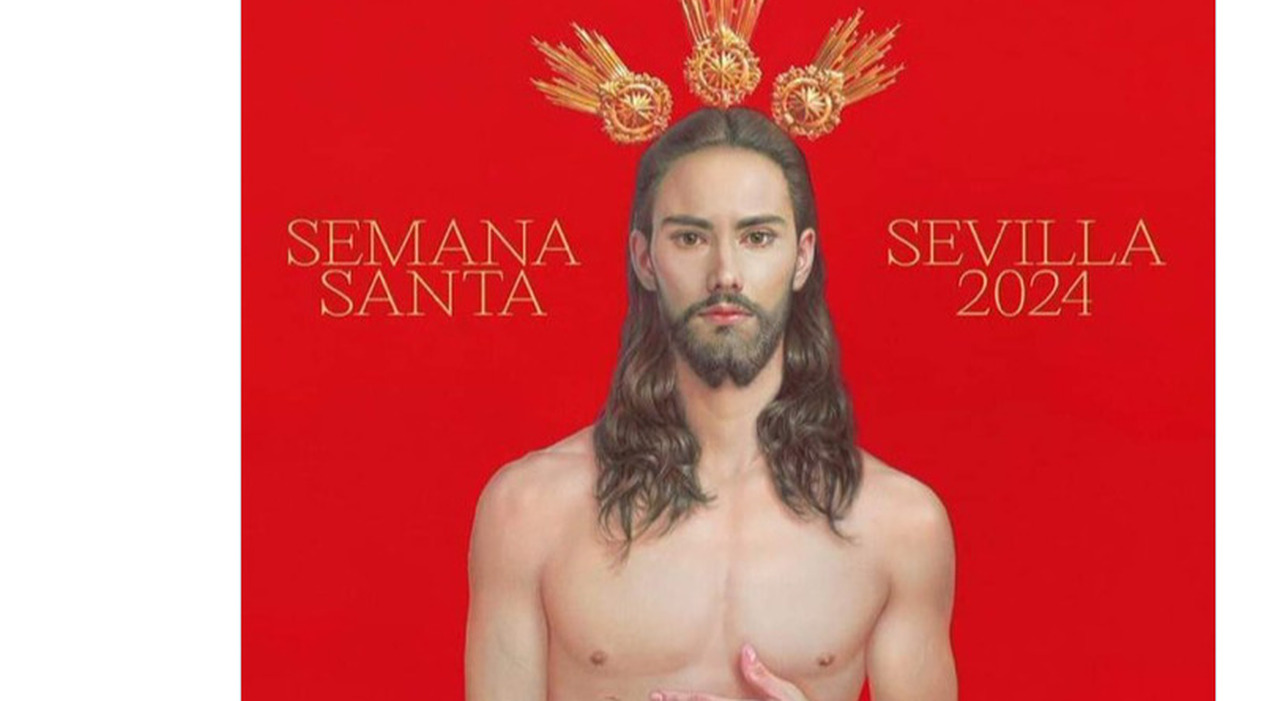A recently resurrected Christ with the features of an iconic model taken from queer-culture, wavy hair down to his shoulders, a very well-groomed beard, skin without a wrinkle, eyes with a thread of eyeliner, muscles well in sight and a scenic loincloth, made up of a drapery held back by a silk cord. This image created by the painter Salustiano Garcia was chosen to represent this year's famous Holy Week in Seville, a spectacular and scenic setup known worldwide that since the 16th century represents the Way of the Cross and the last moments of life, up to the crucifixion of Jesus. The Holy Week in Seville is one of the most heartfelt religious manifestations in all of Spain, capable of attracting thousands and thousands of faithful, as well as being a reference point for national tourism as it is so suggestive and majestic.
The billboard was unveiled a few days ago at an event of the Council of Brotherhoods of Seville in the presence of the mayor, José Luis Sanz, and the author, the painter Garcia, who for his Christ was inspired by his son Horacio. "I needed a model and I had the solution at hand: my son Horacio is beautiful, like the angels", he explained. Since then there has been no peace and on this choice defined as blasphemous, indignant criticisms have rained down first on the city's account dedicated to the initiative and then spread like wildfire, creating an international case about the opportunity to ridicule Jesus Christ once again, making him a kind of caricature, the emblem of gay pride.
In response to the harshest reactions, the painter explained that his entire artistic production is also based on his spirituality, "so - he stressed - I focused the image on the resurrection, to give hope to all of us who are Catholics". His son Horacio also had to intervene in his defense, saying he was surprised, making it clear that it is not a provocation. However, he acknowledged that when, once the oil painting was finished, his father showed it to him, he got goosebumps. "For me it is an honor" to represent the risen Christ, he added, saying he was "very happy and admired" of his father's work.
Despite the heated debate and the clash between those who cry out for yet another sacrilegious act and those who, on the other hand, defend that poster for its beauty and artistic courage, the diocese of Seville seems to have chosen to stay on the sidelines, so much so that at the moment no official reactions have arrived probably not to further fuel the storm that has crossed the Spanish borders, spreading globally and once again prompting reflection on whether it is correct to exploit religious symbols - of any faith - to provoke or advertise events or products. A complex and articulated debate that has been dragging on for a long time and cyclically resurfaces unresolved. The issue did not appear secondary a few years ago, after the publication of the unfortunate cartoons of Charlie Hebdo that ridiculed the Koran and Muhammad and even ridiculed the moment of Mary's childbirth in Bethlehem. The French bishops, wisely, had dismissed that thorny case with a tweet: "The French Episcopal Conference does not comment on those who only seek to provoke. Is this the kind of controversy that France needs?".
To further fuel the clash within the Church over the choice of the model of the Christ of Seville is the comparison between progressives and conservatives on the great question of homosexuality. German bishops have been pushing for years for the Vatican to come to delete some points of the Catechism of the Catholic Church in which homosexuality is included among serious sins, and defined as a moral disorder that requires personal correction and absolute abstinence. For conservatives, this magisterial line has its roots in the sacred scriptures and cannot be changed or minimized, although homosexual people must be welcomed within the Church and treated with mercy. The latest act of this battle concerns the blessing of gay couples decided by the Pope with a document approved in December and subsequently corrected. Even a few days ago he clarified that the blessing is not for the couple, but for the individual homosexual. Meanwhile, the internal clash continues and does not seem destined to die out quickly.
This article is automatically translated
